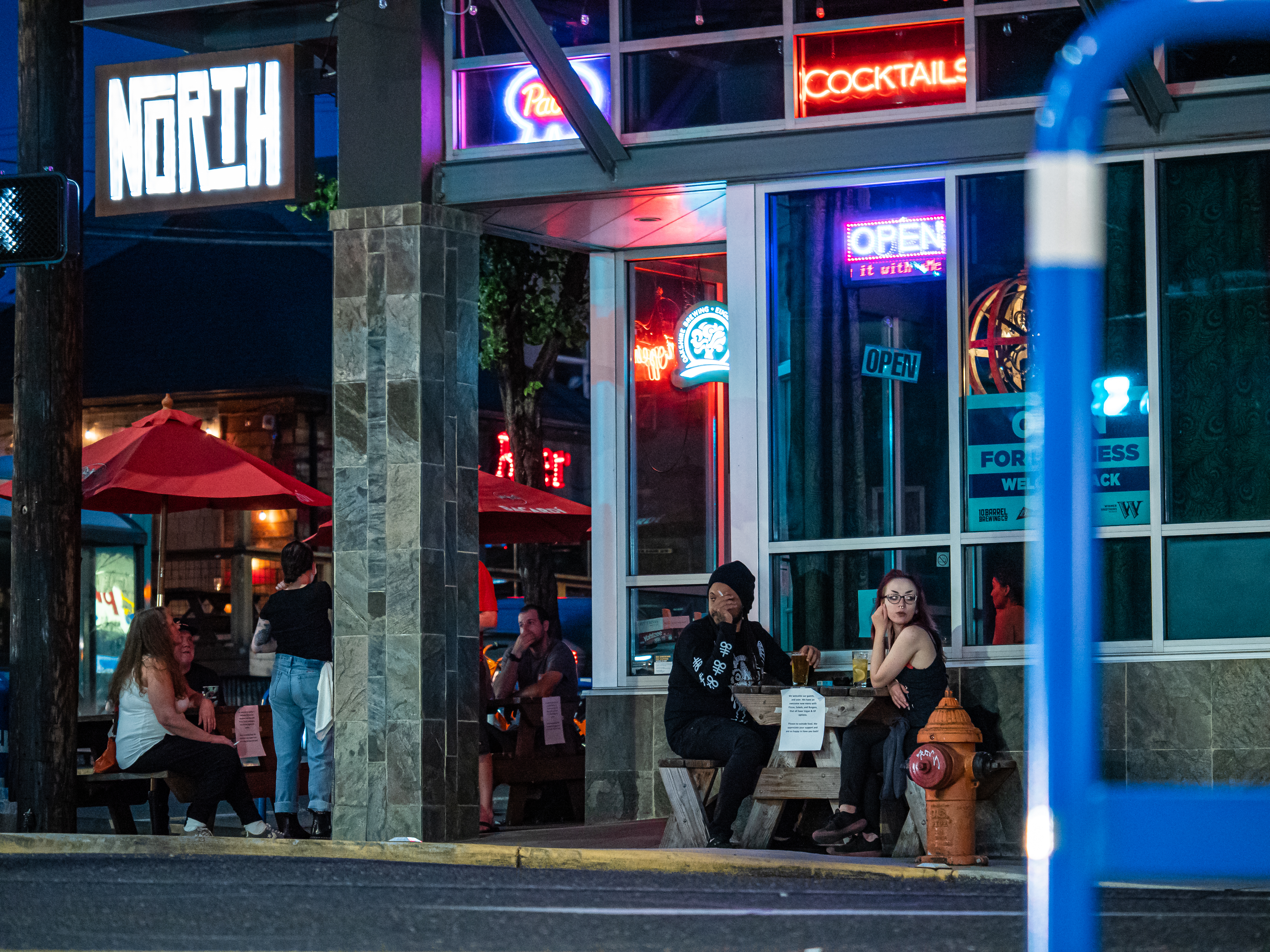Each night for the past three weeks, the primary action in downtown Portland was protesters pressing against a chain-link fence surrounding the Multnomah County Justice Center.
But on June 21, just 11 blocks north, a new phenomenon: half-naked go-go dancers.
Two nights after Gov. Kate Brown allowed some businesses in Multnomah County to reopen, rock club Dante's held its first paid event in three months: Sinferno Cabaret, the weekly burlesque show it has hosted for two decades.
As lingerie-clad dancers undulated onstage to songs that included a remix of Childish Gambino's "This is America," about two dozen patrons watched from seats spaced six feet apart, with the exception of one man who was more interested in the video poker machines. Before entering the venue, each attendee submitted to a temperature check at the door. Once inside, many patrons appeared to remove their masks—which is allowed when eating or drinking.
The MC encouraged the audience to tip the dancers, as each one would donate their earnings to different causes, including the American Civil Liberties Union and the National Urban League.
"It's really easy to get people excited about tits and ass," says dancer Mystic O'Reilley. "It's a lot harder to get people excited about civil rights."
For the past 12 weeks, Portlanders have waited for the go-ahead signal to reemerge from lockdown, watching with envy and fear as every Oregon county but Multnomah was approved to reopen by the governor.

The wait was extended an additional week after Oregon's most populous county experienced an alarming rise in COVID-19 cases. On June 17, Gov. Brown allowed Multnomah County to resume drinking and dining together, even though the rise in cases showed no signs of slowing.
Three months is enough time to reverse habits, and 7,000 cases is a lot of sickness. That made once-common sights appear uncanny, almost sinister. Burlesque dancers, once a staple of Old Town, felt as alien as barber shops, tattoo parlors and ordering a shot at Kelly's Olympian.
As with the rest of the state, Portland opened unevenly, with the action concentrated in the businesses eager—or desperate—to serve customers. Many Portland blocks saw little difference: Civic mainstays from Reel M Inn to the Zipper stuck to takeout service. In other places, especially on the westside, the 10 pm bar curfew only seemed to intensify the activity, packing it into a smaller window of time.
Our reporters wandered into several corners of the city, seeing how Portland residents took their first steps back into old customs—some more enthusiastically than others. Here's what we observed.

Nob Hill
9 pm Friday, June 19
By 8 pm, Scott Edwards and Sam Kazmer were officially starving.
The two friends had put their names on the list at Bantam Tavern, the neighborhood bar now using the parking lot it shares with Indian restaurant Swagat as an outdoor dining area. Its eight picnic tables were full, as was the bar's snug indoor seating—two booths, a third out of commission to provide proper spacing, plus two counters. An hour wait.
"So we were like, 'All right, let's walk down the street and get a snack,'" says Edwards, a 31-year-old Nike employee.
The pair managed to get seated outside at McMenamins Blue Moon. But after 15 minutes, no server emerged to take their order. So Edwards and Kazmer decamped to Top Burmese, where they had the tiny dining room all to themselves and ordered samosas to tide them over.
It was a similar scene up and down Northwest 21st Avenue. At SanSai Japanese Grill, a single solo diner sat indoors, with two parties at outdoor tables. A few blocks away, Schmizza Pub and Grub was back to offering karaoke—against Gov. Brown's orders. A smattering of customers looked on as a woman belted out Rush's "Tom Sawyer" from behind a powder-blue mask.
Edwards and Kazmer had returned to Bantam Tavern, hoping to finally get a seat and a full meal. The bar was no longer taking names for the wait list—per the rules of Phase 1, closing time was only an hour away.
But for Edwards, at least, the hassle beat cooking at home for the umpteenth time in a row."I'm still a little cautious, but I've been getting restless for sure," he says. And he'll certainly be eating out again—"if we don't reclose, which feels like a possibility," he adds. JASON COHEN.

Kerns
2:30 pm Saturday, June 20
Todd Hammer could barely keep up.
"Everyone wants in," said the hairstylist at Holiday Hair Studio in Kerns. "This is a crazy day for me. I started at 8 am and I probably won't finish until 8:30 tonight. It's nonstop."
It was Hammer's first day back on the job in three months, and he had eight back-to-back appointments. As each client left his chair, Hammer took the barber cape tied around their necks and threw it in the nearby washing machine. While the capes soaked, Hammer cleaned each of his tools with more precision than he was taught at cosmetology school.
But the laundry wasn't fast enough to keep up with the stream of customers. So he jumped on Amazon Prime and ordered a dozen more capes.
In his chair was Linda, wearing a bubblegum-pink mask and over 100 foils in her blond hair. She drove in from Vancouver, and hadn't had her hair done since December.
"Todd has never seen my hair this dark," she said, motioning to her roots wrapped in aluminum. "I was very, very happy they reopened. I was desperate."
Four blocks north, at Bishops Barbershop, Lane Barrington felt the same about his hair. "It's the longest it's been in years and years," he laughs. "My girlfriend cut her own hair for the time, and I was afraid of her doing that to me."
Before his appointment, Lily Allen, who works the front desk, took Barrington's temperature with a no-touch forehead thermometer. No customers had put up a fuss about getting their temperature taken or the mask requirement.
After a quick 15 minutes, Barrington emerged from the chair, his once-shaggy locks now high and tight. He looked like a new man.
"I feel like one," he said. MEIRA GEBEL.

The Pearl District
9:01 pm Saturday, June 20
The sun hadn't even set, and it was already nearing last call at River Pig Saloon.
Per the governor's orders, during this first phase of reopening for Multnomah County, all bars and restaurants must stop serving customers at 10 pm. And while the crowd at this University of Oregon-supporting sports bar didn't appear to get the message about wearing masks indoors, it sure seemed aware of the early closing time: At a point of the night when most clubs would normally be mixing their first vodka sodas, the place was at maximum capacity. A slew of young professionals socialized on the boardwalk outside, as club music bounced.
A line formed outside, at least five customers deep, and getting deeper. A group of five walked up, and the bouncer—abiding by the face mask rule, like the rest of the staff—greeted them with a handshake, just like in pre-COVID times.
It was a similar scene an hour earlier at Jake's Famous Crawfish. A group of four christened the return of dine-in service with steak, followed by glasses of Crown Royal on the rocks. Another woman stumbled toward the bartender and ordered a bottle of "champ-pan-yain." When a couple on the sidewalk, dressed like they'd just gotten married, walked past the restaurant's large main window, everyone inside raised a glass to them.
Back at River Pig, a young man in a long sleeve shirt who'd been waiting to get in for about 20 minutes finally gave up. It was almost last call, and he lost faith he'd get in. He left the line and headed toward downtown.
This reporter also left. "Come back earlier next time," the bouncer shouted.
Two hours later, another crowd formed outside the Justice Center—around 300 people, protesting police brutality for the 22nd straight night. Among them was a familiar face: the guy from the front of the line at River Pig, holding a can of hard seltzer. SERGIO OLMOS.

St. Johns
3:10 pm Sunday, June 21
From the reception desk at Peak Performance, Kris Whitley watched a steady stream of people file into the Mousetrap Tavern across North Lombard Street. At the gym where he works, the return of customers was more like a trickle.
"There's the tavern and the waffle truck," says Whitley, referring to Peak Performance's neighbors. "The gym is the slowest. A lot of people seem very hesitant to come in."
At the moment, only four people were working out in the mirror-lined, air conditioning-blasted space about the size of a basketball court. Blue arrows on the floor governed traffic flow, disinfectant spray was stationed throughout the room, and a sign on every other treadmill and elliptical read "Out of Order"—the machines all worked fine, it was just to keep sweaty patrons from working out next to one another.
On the front desk sat a plastic device Whitley referred to as a "fogger," which looked like a small leaf blower. Whitley used it to mist the equipment with a disinfectant solution throughout the day.
Kyle Wagner—a regular at Peak Performance for four years—was practically beaming as he wiped down the weight plates he'd just used. Without lifting to burn off steam the past few months, he'd been going for outdoor runs.
"I hated every second of it," says Wagner. "It's just really good to be back." SHANNON GORMLEY.
Correction: A previous version of this article implied that Dante's was allowing patrons to enter the building without wearing masks, which is incorrect. WW regrets the error.

